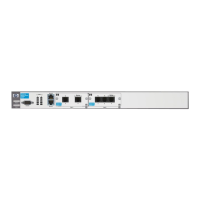11-10
IP Routing—Configuring Static Routes
Overview
Dynamic Routing Protocols
Routers can also construct their routing tables using dynamic routing proto-
cols. The ProCurve Secure Router supports three routing protocols, each of
which it can use alone or in conjunction with the others:
■ RIP versions 1 and 2
■ Open Shortest Path First (OSPF) version 2
■ Border Gateway Protocol (BGP) version 4
See Chapter 15: IP Routing—Configuring RIP, OSPF, BGP, and PBR in the
ProCurve Secure Router Advanced Management and Configuration Guide
to learn how to configure these protocols.
Static Routing Versus Dynamic Routing
Static routing is secure because it provides you the tightest control over traffic
flow: you determine exactly which connection the router uses to forward
traffic to each destination. Static routing is also relatively reliable (although
it does open room for human error).
On a router in a small network with a single exit to a remote site or the Internet,
static routing is effective and simple to configure.
However, as a network expands, configuring all the necessary static routes
can become more and more complicated and time-consuming. Ensuring that
all routes remain accurate can also unduly burden an IT staff. Every time you
want to add a connection or change a route, you must configure the change
on every router in the network. Routers do not automatically respond to a
failed connection, so traffic can be misrouted.
Note Network monitoring can provide a mechanism for detecting failed static
routes. See the Advanced Management and Configuration Guide, Chapter
9: Network Monitoring.
Dynamic routing can provide reliable routes. OSPF selects routes according
to fairly sophisticated criteria, such as link state and bandwidth, and BGP,
though complicated to configure, can take an organization’s policies into
account when selecting routes. What is the best route at one moment may not
always be the best route, and dynamic routing protocols can track these
changes. Dynamic routing also adapts well to changes in network topology,
such as node failures and network expansion.

